The Wind Parks Distorted Development in Greek Islands—Lessons Learned and Proposals Toward Rational Planning
Abstract
1. Introduction
- The western coastline of Europe, starting from Portugal and Spain, expanding to France, and ending at the British western shore (Ireland and Scotland) and the Scandinavian coastline (Norway, Iceland, Denmark, and the Faroe Islands) [6]. The major disadvantage of this region is the intensive seasonal fluctuation of the wind potential characterized by the strong winds in the winter period, often beyond the wind turbines’ operation limits, and the calm summer season [7].
- The Mediterranean region, including southern France, Corsica, the Balearic Islands, the Italian islands of Sardinia and Sicily, and the Greek Aegean Sea Islands [8]. This area is characterized by higher-quality wind potential (lower turbulence and fewer wind gusts) and, in some cases (Corsica, and the Italian and Greek islands), nearly continuous availability during the whole annual period due to local blowing winds in summer caused by the cold, high-pressure air masses above the Alps and the Balkans and the hot, low-pressure air masses above the Sahara Desert [9].
- The direct vicinity of these areas to the open sea and the coastlines, enabling the strong sea winds to be available onshore;
- The mountainous land terrain, which creates local wind flow acceleration conditions (Venturi effect), increasing further the wind power density locally at specific sites.
2. Scope and Methodology
- To interpret and analyze the reasons and the facts that have led to the existing situation;
- To estimate any potential benefits and impacts on the natural environment and human activities that can be anticipated from the licensed wind parks or those with submitted licensing applications;
- To depict the prevailing common opinion;
- To essentially propose measures and actions toward the remedy of the configured reality and the deployment of the available wind potential in the country, following a more rational and effective process that can lead to the maximization of the expected benefits for the local communities.
- An analytic presentation of the existing formulated situation: this includes the available renewable potential and the power demand in Crete, the legal framework, the mapping of the submitted applications and the licenses issued for wind parks and other technologies in Crete, and the interpretation of the existing parameters and analysis of the reasons that have contributed to the formation of the current situation;
- An estimation of benefits and impacts from the licensed or submitted projects;
- A depiction of the public opinion on wind parks in Crete through a statistical survey;
- Proposed measures and actions toward a remedy for the formulated situation from the so far inadequate process applied to the implementation of wind park projects.
3. Depiction of the Current State
3.1. Power Demand and Production and Renewable Energy Potential in Crete and Challenges
- Thermal generators (steam turbines, diesel generators, gas turbines and a combined cycle), with total nominal capacity of 844 MW, installed in three thermal power plants on the island, consuming imported heavy fuel and diesel oil;
- Wind parks (210 MW) and photovoltaic stations (120 MW);
- The electricity imported from the grid of mainland Greece after the electrical interconnection of Crete with the mainland country.
- Intense seasonal fluctuation in power demand between winter and summer, requiring the installation of high production capacity, which remains on stand-by mode for roughly half of the year [51];
- High wind and solar potential, which leads to non-guaranteed power production, requiring the combined installation of large electricity storage plants [52];
- The need to combine the existing sensitive natural ecosystems, often Natura 2000 sites and wildlife habitats, with the installation of large RES projects [55];
- Potential conflicts of the RES projects with the main existing professional or recreational activities [56];
- The funding of the RES projects;
- The low awareness of energy transition and of RES projects of the average local residents in the islands [57];
- The generally low purchasing power of the Greek Islanders, which restricts their capacity to be actively engaged in RES and energy transition projects;
- The existing electrical grid infrastructure, which may be inadequate in some cases to host new RES projects.
3.2. Basic Points in the Legal Framework
3.3. Submitted Applications, Issued Licenses, and Legal Amendments
3.4. Parameters’ Interpretation and Analysis of Reasons
- The potential for the submission of large RES projects from private actors in insular electrical systems with concurrent construction of the underwater interconnection cable with the mainland grid;
- The ambiguity regarding the measuring location of the legally required certified wind potential measurement in relation to the wind park’s installation site;
- The removal, in 2011, of the applicant’s obligation to justify the land property right for the proposed wind park’s installation site within the process of the Power Production Permit issuance from RAE;
- The fact that once an application for an RES project has been submitted or a license has been issued on a specific geographical site, no other project can be submitted for the same site afterwards.
4. Benefits and Impacts from the Applied Policy
4.1. Benefits from the Large Wind Parks
4.2. Occupation of the Available Geographical Space
4.3. Occupation of the Available Electrical Space
4.4. Impacts on the Natural Environment and Human Activities
4.5. Deceleration of Energy Transition
4.6. Economic Consequences
4.7. Social Consequences
5. The Public Opinion
5.1. Questionnaire Participants
5.2. Methodology
- Individual question analysis: Each question was examined independently, producing descriptive statistics such as mean scores and frequency distributions.
- Cross-question analysis: Responses to specific questions were analyzed with respect to answers to related items, allowing for the investigation of potential correlations or patterns across domains (e.g., perception of environmental impact versus economic benefits).
- In order to assess the reliability of the survey, the Cronbach’s alpha statistic was used [84]. Cronbach’s alpha (α) is used to assess internal consistency reliability, indicating the consistency of replies to similar questions. Values range from 0 to 1, with α ≥ 0.7 typically considered acceptable, α ≥ 0.8 good, and α ≥ 0.9 excellent for most social science research, while values below 0.5 suggest poor reliability. The reference thresholds provide a framework for evaluating whether our survey items consistently captured attitudes toward wind energy, though we acknowledge that reliability alone does not guarantee validity.
5.3. Trust
5.4. Agreement with Assertions About Wind Turbines
5.5. Acceptable Distance of Wind Parks
5.6. Participation in Wind Park Promotion and Development
5.7. Onshore vs. Offshore
5.8. Potential Limitations
- Regional adaptations: If wind acceptance varies by geographical or cultural context, future studies could adapt the questionnaire to address location-specific concerns.
- Extended sampling: A broader or more diverse sampling pool would improve generalizability.
- Advanced statistical modeling: Future work could apply clustering or latent class modeling to classify respondents according to their environmental attitudes, trust levels, or socio-demographic attributes.
6. Proposed Measures and Actions
- Minimization of the electricity procurement cost, support of vulnerable households with specific measures, and remedying energy poverty;
- The new RES projects should be sited and designed to ensure the elimination of any impacts on the natural environment and on the existing human activities;
- Extensive participation of the citizens and local small firms as investors in the funding scheme for the development of electricity production projects using RES technologies, most probably through their participation and involvement in energy communities, so the profits from the produced electricity selling can be returned to them or reinvested for the implementation of more RESs or projects for the common benefit.
- The need to support the real energy communities in Greece, introduced as a legal entity for first time in 2018 [85], should be acknowledged. Specifically, the introduction in the legislation of the concept of “energy communities of broad basis” has been repeatedly proposed as those with large memberships, participation of municipalities, and clear developmental and social orientations proved by their already-implemented works. This is necessary in order to make possible the distinction between these large communities and the smaller ones, which have mainly a profit-driven attitude. The concept of “energy communities of broad basis” should be officially introduced in the legislation.
- For the energy communities of broad basis, absolute licensing priorities should be defined, while funding-supportive mechanisms and incentives should be supplied [86] based on the mobilization of European Union’s funds, including the European Regional Development Fund, the newly announced Islands Decarbonisation Fund, and the upcoming Social Climate Fund. Practically, the energy communities of broad basis should be assigned a licensing priority of rank A (the highest one). Additionally, new funding calls, based on the aforementioned funding programs and resources, should be exclusively designed for these energy communities.
- The two large wind park licenses in Crete should be revoked, given the undemocratic and unconstitutional way through which their implementation potential has been prolonged. This should be accomplished with a corresponding legal amendment.
- The large wind park applications in Crete and in other Greek islands should be rejected, given the unreasonably long time periods of more than 12 years during which they have remained under evaluation. For this measure, only the strict application of the already existing legal framework is required.
- Once the existing licenses and applications have been revoked or rejected, respectively, a new spatial plan for the installation of electricity and heat production projects from RESs, including both onshore and offshore wind parks, and a new energy transition plan should be accomplished, on the application level, with the cooperation of the local involved stakeholders: municipalities, licensing authorities, academia, and energy communities of broad basis. The outcome of these working groups will be a final and very specific energy transition plan, describing specifically the number of energy transition projects (production, storage, saving) with their essential details that will be implemented in each island: size, technology, siting, and operation mode. This plan should officially be acknowledged, adopted, and applied by the Greek State following a relevant legal regulation. Any RES project or energy-saving project that originates from local energy communities of broad basis or municipal authorities should be strongly and officially supported and prioritized, both on the licensing and funding level, following the legal amendments and the funding mechanisms proposed in the previous point.
- The local actors should have the first and the last word on the way, the locations, the size, and the technologies of the energy transition projects that will be applied in their territories. In order to minimize any potential environmental impacts, the adoption of effective mitigation strategies including alternative site selection based on sustainability criteria [87], advanced turbine technology, and environmental monitoring can be critical [88]. All these should be applied to both onshore and offshore wind parks. To this end, the final decision for the approval of the environmental impact studies for the RES projects should be assigned to the local licensing authorities instead of the centralized Ministry authority, which today has the responsibility for the final approval. The positive public opinion, expressed, perhaps, through the official decisions of the municipal council, should be also upgraded to a necessarily required criterion for the final approval of a RES project. Until today, the municipal council decision has only a complementary role.
- For the development of new RES projects, a minimum percentage of the available energy and geographical space should be captured for the local stakeholders. This also should be applied for the offshore wind parks. This percentage has been proposed by the local actors to be 100% for small islands with populations lower than 10,000 and at least 70% for the large ones. For the offshore wind parks, 20% of the total installed power should be dedicated to local authorities and energy communities of broad basis. This specific proposed measure can drastically contribute to the elimination of the risk of energy monopolies.
- The role of real energy communities can be multiple, starting from capacity building, the rational use of energy [89,90], and, of course, energy production and management, from a decentralized scale [91] to the implementation of centralized plants of either large [92] or small size [93], which can undertake the main power or heat production role in a geographical territory. All this potential should be officially acknowledged and supported by the State. In practice, this can be achieved with specific initiatives that will strengthen the role of energy communities, such as new calls to foster the collaboration of energy communities and municipalities, assignment of capacity-building projects to energy communities, etc.
- The design and implementation of proper and effective promotion and dissemination campaigns by energy communities to inform local stakeholders of the implemented projects and the successfully completed achievements, focusing on raising awareness of energy transition topics such as the necessity, the pylons and the routes, the potential benefits and the risks, etc.;
- The implementation of pilot projects, especially with innovative technologies, with the funding support of national or European initiatives (in the case of the European Union);
- The implementation of common RES projects such as the net-metering photovoltaic plants of the Minoan Energy Community in Crete, which strengthen the public trust in energy communities and play the role of living and real labs, offering the required know-how for all implementation and operation stages and aspects: planning, licensing, funding, operation, and maintenance;
- The collaboration of energy communities with municipalities to support the energy transition of municipal facilities.
7. Conclusions—Hints for Further Research
- Investigation of similar distorted approaches in other countries, evaluation of the reasons, and estimation of potential treatments;
- Investigation of large wind parks’ long-term impacts on the natural environment and on existing economic or recreational human activities;
- Evaluation of the socio-economic effects of energy monopolies and of the deterioration and distortion of the electricity wholesale market;
- The potential role of energy communities in economic and social development;
- Innovative technologies for small-scale and decentralized wind energy deployment.
Author Contributions
Funding
Data Availability Statement
Acknowledgments
Conflicts of Interest
References
- Eurostat: Electricity from Renewables Sources up to 41% in 2022. Available online: https://ec.europa.eu/eurostat/en/web/products-eurostat-news/w/ddn-20240221-1 (accessed on 16 January 2025).
- Review Energy. In 2022, 39% of the EU’s Electricity Was Generated by Renewables. 2023. Available online: https://www.review-energy.com/otras-fuentes/in-2022-39-of-the-eu-s-electricity-was-generated-by-renewables (accessed on 16 January 2025).
- Dupré la Tour, M.A. Photovoltaic and wind energy potential in Europe—A systematic review. Renew. Sustain. Energy Rev. 2023, 179, 113189. [Google Scholar] [CrossRef]
- Enevoldsen, P.; Permien, F.H.; Bakhtaoui, I.; von Krauland, A.K.; Jacobson, M.Z.; Xydis, G.; Sovacool, B.K.; Valentine, S.C.; Luecht, D.; Oxley, G. How much wind power potential does europe have? Examining european wind power potential with an enhanced socio-technical atlas. Energy Policy 2019, 132, 1092–1100. [Google Scholar] [CrossRef]
- Hassan, O.; Nassar, A.K.; Khudhair Al-Jiboory, A.; Viktor, P.; Telba, A.A.; Mahrous Awwad, E.; Amjad, A.; Falah Fakhruldeen, H.; Algburi, S.; Chayid Mashkoor, S.; et al. Mapping Europe renewable energy landscape: Insights into solar, wind, hydro, and green hydrogen production. Technol. Soc. 2024, 77, 102535. [Google Scholar] [CrossRef]
- Martinez, A.; Iglesias, G. Levelized cost of energy to evaluate the economic viability of floating offshore wind in the European Atlantic and Mediterranean. e-Prime-Adv. Electr. Eng. Electron. Energy 2024, 8, 100562. [Google Scholar] [CrossRef]
- Carlini, F.; Christensen, B.J.; Datta Gupta, N.; Santucci de Magistris, P. Climate, wind energy, and CO2 emissions from energy production in Denmark. Energy Econ. 2023, 125, 106821. [Google Scholar] [CrossRef]
- Majidi Nezhad, M.; Groppi, D.; Marzialetti, P.; Fusilli, L.; Laneve, G.; Cumo, F.; Astiaso Garcia, D. Wind energy potential analysis using Sentinel-1 satellite: A review and a case study on Mediterranean islands. Renew. Sustain. Energy Rev. 2019, 109, 499–513. [Google Scholar] [CrossRef]
- Katikas, L.; Dimitriadis, P.; Koutsoyiannis, D.; Kontos, T.; Kyriakidis, P. A stochastic simulation scheme for the long-term persistence, heavy-tailed and double periodic behavior of observational and reanalysis wind time-series. Appl. Energy 2021, 295, 116873. [Google Scholar] [CrossRef]
- European Environmental Agency: Natura 2000 Viewer. Available online: https://natura2000.eea.europa.eu/ (accessed on 16 January 2025).
- Kati, V.; Kassara, C.; Vrontisi, Z.; Moustakas, A. The biodiversity-wind energy-land use nexus in a global biodiversity hotspot. Sci. Total Environ. 2021, 768, 144471. [Google Scholar] [CrossRef]
- Bright, J.; Langston, R.; Bullman, R.; Evans, R.; Gardner, S.; Pearce-Higgins, J. Map of bird sensitivities to wind farms in Scotland: A tool to aid planning and conservation. Biol. Conserv. 2008, 141, 2342–2356. [Google Scholar] [CrossRef]
- Balotari-Chiebao, F.; Santangeli, A.; Piirainen, S.; Byholm, P. Wind energy expansion and birds: Identifying priority areas for impact avoidance at a national level. Biol. Conserv. 2023, 277, 109851. [Google Scholar] [CrossRef]
- Harper, M.; Anderson, B.; James, P.; Bahaj, A. Assessing socially acceptable locations for onshore wind energy using a GIS-MCDA approach. Int. J. Low-Carbon. Technol. 2019, 14, 160–169. [Google Scholar] [CrossRef]
- Sobrinho, M.F.J.; Ramirez Hernandez, M.C.; Albano Amora, S.S.; Costa de Morais, E.R. Perception of Environmental Impacts of Wind Farms in Agricultural Areas of Northeast Brazil. Energies 2022, 15, 101. [Google Scholar] [CrossRef]
- Broekel, T.; Alfken, C. Gone with the wind? The impact of wind turbines on tourism demand. Energy Policy 2015, 86, 506–519. [Google Scholar] [CrossRef]
- Dai, K.; Bergot, A.; Liang, C.; Xiang, W.N.; Huang, Z. Environmental issues associated with wind energy—A review. Renew. Energy 2015, 75, 911–921. [Google Scholar] [CrossRef]
- Phillips, J. A quantitative-based evaluation of the environmental impact and sustainability of a proposed onshore wind farm in the United Kingdom. Renew. Sustain. Energy Rev. 2015, 49, 1261–1270. [Google Scholar] [CrossRef]
- Leung, D.Y.C.; Yang, Y. Wind energy development and its environmental impact: A review. Renew. Sustain. Energy Rev. 2012, 16, 1031–1039. [Google Scholar] [CrossRef]
- McKenna, R.; Pfenninger, S.; Heinrichs, H.; Schmidt, J.; Staffell, J.; Bauer, C.; Gruber, K.; Hahmann, A.N.; Jansen, M.; Klingler, M.; et al. High-resolution large-scale onshore wind energy assessments: A review of potential definitions, methodologies and future research needs. Renew. Energy 2022, 182, 659–684. [Google Scholar] [CrossRef]
- Buchmayr, A.; Verhofstadt, E.; Van Ootegem, L.; Thomassen, G.; Taelman, S.E.; Dewulf, J. Exploring the global and local social sustainability of wind energy technologies: An application of a social impact assessment framework. Appl. Energy 2022, 312, 118808. [Google Scholar] [CrossRef]
- Kaldellis, J.K.; Boulogiorgou, D. 2.19: Social Acceptability of Wind Power Projects. Compr. Renew. Energy (Second Ed.) 2022, 2, 628–643. [Google Scholar]
- Nazir, M.S.; Bilal, M.; Sohail, H.M.; Liu, B.; Chen, W.; Iqbal, H.M. Impacts of renewable energy atlas: Reaping the benefits of renewables and biodiversity threats. Int. J. Hydrogen Energy 2020, 45, 22113–22124. [Google Scholar] [CrossRef]
- Chalkiadakis, G.; Akasiadis, C.; Savvakis, N.; Tsoutsos, T.; Hoppe, T.; Coenen, F. Providing a scientific arm to renewable energy cooperatives. Green. Energy Technol. 2018, 717–731. [Google Scholar]
- Katsaprakakis, D.A.; Dakanali, E.; Dimopoulos, A.; Gyllis, Y. Energy Transition on Sifnos: An approach to economic and social transition and development. Appl. Sci. 2022, 12, 2680. [Google Scholar] [CrossRef]
- Nazir, M.S.; Alturise, F.; Alshmrany, S.; Nazir, H.M.J.; Bilal, M.; Abdalla, A.N.; Sanjeevikumar, P.; Ali, Z.M. Wind Generation Forecasting Methods and Proliferation of Artificial Neural Network: A Review of Five Years Research Trend. Sustainability 2020, 12, 3778. [Google Scholar] [CrossRef]
- Garcia Latorre, F.J.; Quintana, J.J.; de la Nuez, I. Technical and economic evaluation of the integration of a wind-hydro system in El Hierro island. Renew. Energy 2019, 134, 186–193. [Google Scholar] [CrossRef]
- Katsaprakakis, D.A.; Christakis, D.G. Maximisation of R.E.S. penetration in Greek insular isolated power systems with the introduction of pumped storage systems. In Proceedings of the European Wind Energy Conference and Exhibition, Marseille, France, 16–19 March 2009; pp. 4918–4930. [Google Scholar]
- Katsaprakakis, D.A.; Christakis, D.G. A wind parks, pumped storage and diesel engines power system for the electric power production in Astypalaia. In Proceedings of the European Wind Energy Conference and Exhibition, Athens, Greece, 27 February–2 March 2006; pp. 621–636. [Google Scholar]
- Pompodakis, E.E.; Kryonidis, G.C.; Karapidakis, E.S. Optimizing the installation of hybrid power plants in non-interconnected islands. J. Energy Storage 2023, 74, 109511. [Google Scholar] [CrossRef]
- Margosi, M.; Koukoufikis, G. Fostering Energy Justice through Decentralised Transition: The Case of Energy Communities in Greece. Eur. J. Spat. Dev. 2024, 21, 33–60. [Google Scholar]
- Sperling, K. How does a pioneer community energy project succeed in practice? The case of the Samsø Renewable Energy Island. Renew. Sustain. Energy Rev. 2017, 71, 884–897. [Google Scholar] [CrossRef]
- Jantzen, J.; Kristensen, M.; Haunstrup Christensen, T. Sociotechnical transition to smart energy: The case of Samso 1997–2030. Energy 2018, 162, 20–34. [Google Scholar] [CrossRef]
- United Nations Climate Change. Technology Executive Committee. Wind Energy in Denmark. Case Study: Good Practices and Lessons Learnt on the Setup and Implementation of National Systems of Innovation. Available online: https://unfccc.int/ttclear/misc_/StaticFiles/gnwoerk_static/TEC_NSI/63eb6ced5b1e43429a6eccdef95ff61e/85bd141304c5486fb7f2ef71f8d2d45f.pdf (accessed on 28 May 2025).
- European Environment Agency. Share of Energy Consumption from Renewable Sources in Europe. Available online: https://www.eea.europa.eu/en/analysis/indicators/share-of-energy-consumption-from (accessed on 28 May 2025).
- Ecopower Official Web Site. Available online: https://www.ecopower.be/ (accessed on 28 May 2025).
- Windpark Krammer Official Web Site. Available online: https://www.windparkkrammer.nl/ (accessed on 28 May 2025).
- The Westmill Wind Park Official Web Site. Available online: https://www.westmillwind.coop/ (accessed on 28 May 2025).
- Energy Community of Chalki “ChalkiOn” Official Web Site. Available online: https://www.chalkion.gr/index_en.html (accessed on 28 May 2025).
- PPC Renewables. The Naeras Hybrid Power Plant. Available online: https://www.ppcr.gr/en/naeras-hybrid-project (accessed on 28 May 2025).
- IDOM. El Hierro Hydrowind Power Plant—10 MW. Available online: https://www.idom.com/en/project/el-hierro-hydrowind-power-plant-2/ (accessed on 28 May 2025).
- Figari, H.; Dotterud Leiren, M.; Krange, O. After the battle: Emergent norms and the silencing of dissent in a Norwegian wind power community. Energy Res. Soc. Sci. 2024, 118, 103765. [Google Scholar] [CrossRef]
- Berle, E.C.; Broekel, T. Spinning stories: Wind turbines and local narrative landscapes in Germany. Technol. Forecast. Soc. Change 2025, 211, 123892. [Google Scholar] [CrossRef]
- Marcos, A.; Hartmann, P.; Bessette, D.L.; Árvai, J. Partisan winds: Group-level polarization and issue-framing propel attitudes about local wind farms. Energy Res. Soc. Sci. 2025, 119, 103848. [Google Scholar] [CrossRef]
- Wikipedia: Crete. Available online: https://en.wikipedia.org/wiki/Crete (accessed on 17 January 2025).
- European Commission. Photovoltaic Geographical Information System. Country and Regional Maps. Available online: https://re.jrc.ec.europa.eu/pvg_download/map_index.html (accessed on 17 January 2025).
- Christakis, N.; Evangelou, I.; Drikakis, D.; Kossioris, G. A Computational Methodology for Assessing Wind Potential. Energies 2024, 17, 1385. [Google Scholar] [CrossRef]
- Caralis, G.; Christakopoulos, T.; Karellas, S.; Gao, Z. Analysis of energy storage systems to exploit wind energy curtailment in Crete. Renew. Sustain. Energy Rev. 2019, 103, 122–139. [Google Scholar] [CrossRef]
- Tsoutsos, T.; Tsitoura, L.; Kokologos, D.; Kalaitzakis, K. Sustainable siting process in large wind farms case study in Crete. Renew. Energy 2015, 75, 474–480. [Google Scholar] [CrossRef]
- Independent Power Transmission Operator: Ten-Year Network Development Plan. Available online: https://www.admie.gr/en/grid/development/ten-year-development-plan (accessed on 17 January 2025).
- Georgiou, P.N.; Mavrotas, G.; Diakoulaki, D. The effect of islands’ interconnection to the mainland system on the development of renewable energy sources in the Greek power sector. Renew. Sustain. Energy Rev. 2011, 15, 2607–2620. [Google Scholar] [CrossRef]
- Caralis, G.; Papantonis, D.; Zervos, A. The role of pumped storage systems towards the large scale wind integration in the Greek power supply system. Renew. Sustain. Energy Rev. 2012, 16, 2558–2565. [Google Scholar] [CrossRef]
- Ramirez, J.; Böhm, S. Transactional colonialism in wind energy investments: Energy injustices against vulnerable people in the Isthmus of Tehuantepec. Energy Res. Soc. Sci. 2021, 78, 102135. [Google Scholar] [CrossRef]
- Mósesdóttir, L. Energy (in)justice in the green energy transition. The case of Fosen wind farms in Norway. Technol. Soc. 2024, 77, 102563. [Google Scholar] [CrossRef]
- Straka, T.M.; Fritze, M.; Voigt, C.C. The human dimensions of a green–green-dilemma: Lessons learned from the wind energy—wildlife conflict in Germany. Energy Rep. 2020, 6, 1768–1777. [Google Scholar] [CrossRef]
- Frantál, B.; Frolova, M.; Liñán-Chacón, J. Conceptualizing the patterns of land use conflicts in wind energy development: Towards a typology and implications for practice. Energy Res. Soc. Sci. 2023, 95, 102907. [Google Scholar] [CrossRef]
- Ioannidis, F.; Kosmidou, K.; Papanastasiou, D. Public awareness of renewable energy sources and Circular Economy in Greece. Renew. Energy 2023, 206, 1086–1096. [Google Scholar] [CrossRef]
- Katsaprakakis, D.A.; Papadakis, N.; Christakis, D.G.; Zervos, A. On the wind power rejection in the islands of Crete and Rhodes. Wind Energy 2007, 10, 415–434. [Google Scholar] [CrossRef]
- Kaldellis, J.K.; Kavadias, K.A.; Garefallakis, S. Income loss due to wind energy rejected by the Crete island electrical network—the present situation. Appl. Energy 2004, 79, 127–144. [Google Scholar] [CrossRef]
- Regulation of Electricity Production Permits Using Renewable Energy Sources and High Efficiency Heat and Power Cogeneration plant. Official Governmental Gazette 448B/3-4-2007. Available online: https://www.electricallab.gr/e-yliko/2015-12-05-17-42-59-3/319-5707-448-3-4-2007/file (accessed on 12 January 2025).
- Regulation of Electricity Production Permits Using Renewable Energy Sources and High Efficiency Heat and Power Cogeneration plant. Official Governmental Gazette 2373Β/25-10-2011. Available online: https://helapco.gr/nomothesia/yapef114810-kanonismos-adeiwn-paragwghs-hlektrikhs-energeias-me-xrhsh-ape-fek-2373v25-10-2011/ (accessed on 12 January 2025).
- Law 5037/2023; Renaming the Regulatory Authority of Energy to the Regulatory Authority of Waste, Energy and Water and Expanding Its Scope with Responsibilities Over Water Services and Urban Waste Management, Strengthening Water Policy. Modernizing the Legislation for the Use and Production of Electricity from Renewable Sources Through the Integration of EU Directives 2018/2001 and 2019/944. More Specific Provisions on Renewable Energy Sources and Environmental Protection. Official Governmental Gazette 78A/29-3-2023. Available online: https://www.kodiko.gr/nomothesia/document/872080/nomos-5037-2023 (accessed on 12 January 2025).
- Law 3468/2006; Production of Electricity from Renewable Energy Sources and High Efficiency Cogeneration of Electricity and Heat and Other Provisions. Official Governmental Gazette 129A/27-6-2006. Available online: https://www.kodiko.gr/nomothesia/document/11708/nomos-3468-2006 (accessed on 12 January 2025).
- Law 3851/2010; Accelerating the Development of Renewable Energy Sources to Address Climate Change and Other Provisions on Matters Within the Competence of the Ministry of Environment, Energy and Climate Change. Official Governmental Gazette 85A/4-6-2010. Available online: https://www.kodiko.gr/nomothesia/document/55724/nomos-3851-2010 (accessed on 12 January 2025).
- Regulatory Authority of Energy: GeoPortal. Available online: https://geo.rae.gr/ (accessed on 18 January 2025).
- Law 4821/2021; Modernization of the Greek Land Registry, New Digital Services and Strengthening of Digital Governance and Other Provisions. Official Governmental Gazette 134A/31-7-2021. Available online: https://www.kodiko.gr/nomologia/download_fek?f=fek/2021/a/fek_a_134_2021.pdf&t=ab837f610fefec172ac09d93893c288b (accessed on 12 January 2025).
- Law 5151/2024; Arrangements for the Modernization of Waste Management, the Improvement of the Energy Saving Framework, the Development of Energy Projects and the Treatment of Urban Planning Issues. Official Governmental Gazette 173A/4-11-2024. Available online: https://www.kodiko.gr/nomologia/download_fek?f=fek/2024/a/fek_a_173_2024.pdf&t=852e8dff1e0a5cb5848dc35c8a6af02e (accessed on 12 January 2025).
- Regional Authority of Crete: GIS Crete. Forests Map. Available online: https://gis.crete.gov.gr/sdi/?lon=2780579.9920547&lat=4195679.621125&zoom=11&tab=viewport_maptab&loader=map7_loader_public (accessed on 21 January 2025).
- Regional Authority of Crete: GIS Crete. Archaeological and Cultural Interest Sites. Available online: https://gis.crete.gov.gr/sdi/?lon=2780579.9920547&lat=4195679.621125&zoom=11&tab=viewport_maptab&loader=map10_loader_public (accessed on 21 January 2025).
- Decision of RAE, Number 88/2023: Determination of Power Margin of RES Projects in Crete After Completion of Phase II of Its Interconnection with the Greek Electricity Transportation System, According to Paragraph 4 of Clause 100 of Law 4821/2021 (Official Gazette A’134). Available online: https://diavgeia.gov.gr/doc/67%CE%A79%CE%99%CE%94%CE%9E-%CE%969%CE%A4?inline=true (accessed on 19 January 2025).
- Katsaprakakis, D.A.; Michopoulos, A.; Skoulou, V.; Dakanali, E.; Maragkaki, A.; Pappa, S.; Christakis, D.; Condaxakis, C. A Multidisciplinary Approach for an Effective and Rational Energy Transition in Crete Island, Greece. Energies 2022, 15, 3010. [Google Scholar] [CrossRef]
- Meng, L.; Liu, P.; Zhou, Y.; Mei, Y. Blaming the wind? The impact of wind turbine on bird biodiversity. J. Dev. Econ. 2025, 172, 103402. [Google Scholar] [CrossRef]
- Gao, C.; Na, H.; Song, K.; Dyer, N.; Tian, F.; Xu, O.; Xing, Y. Environmental impact analysis of power generation from biomass and wind farms in different locations. Renew. Sustain. Energy Rev. 2019, 102, 307–317. [Google Scholar] [CrossRef]
- Jenniches, S.; Worrell, E.; Fumagalli, E. Regional economic and environmental impacts of wind power developments: A case study of a German region. Energy Policy 2019, 132, 499–514. [Google Scholar] [CrossRef]
- Foteinis, S.; Savvakis, N.; Tsoutsos, T. Energy and environmental performance of photovoltaic cooling using phase change materials under the Mediterranean climate. Energy 2023, 265, 126355. [Google Scholar] [CrossRef]
- Savvakis, N.; Tournaki, S.; Tarasi, D.; Kallergis, N.; Daras, T.; Tsoutsos, T. Environmental effects from the use of traditional biomass for heating in rural areas: A case study of Anogeia, Crete. Environ. Dev. Sustain. 2022, 24, 5473–5495. [Google Scholar] [CrossRef]
- Savvakis, N.; Sifakis, N.; Kotakidis, X.; Arampatzis, G. Multiple energy resources integration in the food industry: A technoeconomic analysis. J. Clean. Prod. 2023, 426, 139055. [Google Scholar] [CrossRef]
- Enex Group. Electricity Market. Available online: https://www.enexgroup.gr/el/home (accessed on 15 January 2025).
- Kitsatoglou, A.; Georgopoulos, G.; Papadopoulos, P.; Antonopoulos, H. An ensemble approach for enhanced Day-Ahead price forecasting in electricity markets. Expert Syst. Appl. 2024, 265, 124971. [Google Scholar] [CrossRef]
- Korfiati, I.P. Classifying like a state: Land dispossession on Eastern Crete’s contested mountains. Antipode 2020, 52, 1331–1350. [Google Scholar] [CrossRef]
- Siamanta, Z.C.; Dunlap, A. ‘Accumulation by wind energy’: Wind energy development as a trojan jorse in Crete, Greece and Oaxaca, Mexico. ACME: An. Int. J. Crit. Geogr. 2019, 18, 925–955. [Google Scholar]
- The Horizon 2020 WENDY Project. Available online: https://wendy-project.eu/ (accessed on 12 February 2025).
- Minoan Energy Community. Available online: https://www.minoanenergy.com/ (accessed on 12 February 2025).
- Streiner, D.L. Starting at the Beginning: An Introduction to Coefficient Alpha and Internal Consistency. J. Pers. Assess. 2003, 80, 99–103. [Google Scholar] [CrossRef]
- Law 4513/2018: Energy Communities and Other Clauses. Official Governmental Gazette 9A/23-1-2018. Available online: https://www.kodiko.gr/nomothesia/document/341480/nomos-4513-2018 (accessed on 21 January 2025).
- Yfanti, S.; Katsaprakakis, D.A.; Sakkas, N.; Condaxakis, C.; Karapidakis, E.; Syntichakis, S.; Stavrakakis, G.M. The Role of Energy Communities in the Achievement of a Region’s Energy Goals: The Case of a Southeast Mediterranean Region. Energies 2025, 18, 1327. [Google Scholar] [CrossRef]
- Alphan, H. Modelling potential visibility of wind turbines: A geospatial approach for planning and impact mitigation. Renew. Sustain. Energy Rev. 2021, 152, 111675. [Google Scholar] [CrossRef]
- Sander, L.; Jung, C.; Schindler, D. Global review on environmental impacts of onshore wind energy in the field of tension between human societies and natural systems. Energies 2024, 17, 3098. [Google Scholar] [CrossRef]
- Yfanti, S.; Sakkas, N.; Karapidakis, E. An event-driven approach for changing user behaviour towards an enhanced building’s energy efficiency. Buildings 2020, 10, 183. [Google Scholar] [CrossRef]
- Yfanti, S.; Sakkas, N.; Vailakis, N.; Nistikaki, A. Environmental Sustainability and Regional Competitiveness: Innovative Steps by a Local Public Authority towards Energy Saving. J. Energy Power Eng. 2019, 13, 149–161. [Google Scholar]
- Katsaprakakis, D.A. Toward a Renewable and Sustainable Energy Pattern in Non-Interconnected Rural Monasteries: A Case Study for the Xenofontos Monastery, Mount Athos. Sustainability 2024, 16, 2111. [Google Scholar] [CrossRef]
- Papadopoulos, A.M. Renewable energies and storage in small insular systems: Potential, perspectives and a case study. Renew. Energy 2020, 149, 103–114. [Google Scholar] [CrossRef]
- Bueno, C.; Carta, J.A. Wind powered pumped hydro storage systems, a means of increasing the penetration of renewable energy in the Canary Islands. Renew. Sustain. Energy Rev. 2006, 10, 312–340. [Google Scholar] [CrossRef]
- Ivelina Mirkova, I.; Padrón-Fumero, N. From vulnerability to resilience: Empowering stakeholder-driven just transitions in island tourism economies. Energy Res. Soc. Sci. 2025, 121, 103966. [Google Scholar] [CrossRef]
- Standal, K.; Dotterud Leiren, M.; Alonso, I.; Azevedo, I.; Kudrenickis, I.; Maleki-Dizaji, P.; Laes, E.; Di Nucci, M.R.; Krug, M. Can renewable energy communities enable a just energy transition? Exploring alignment between stakeholder motivations and needs and EU policy in Latvia, Norway, Portugal and Spain. Energy Res. Soc. Sci. 2023, 106, 103326. [Google Scholar] [CrossRef]
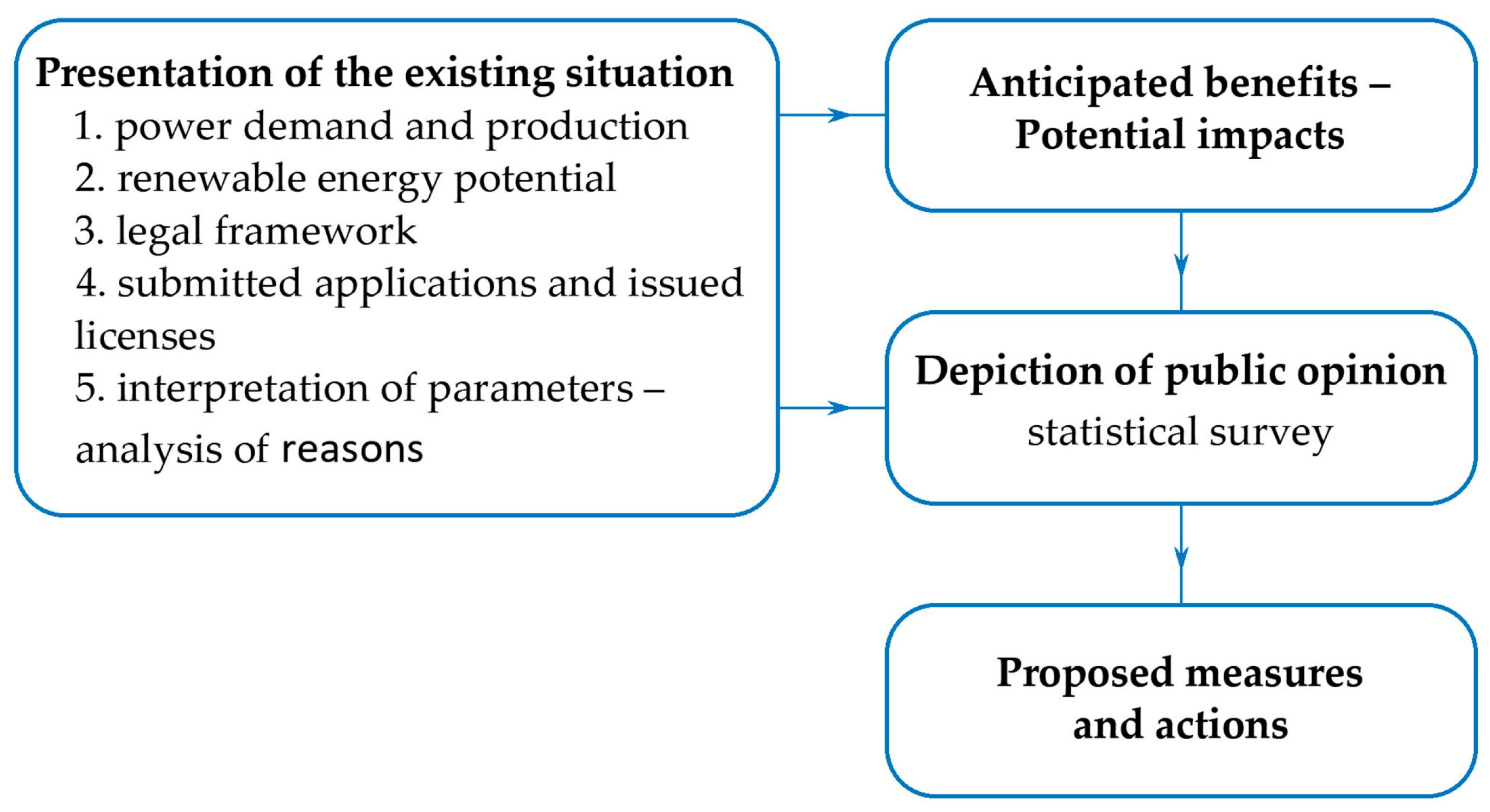
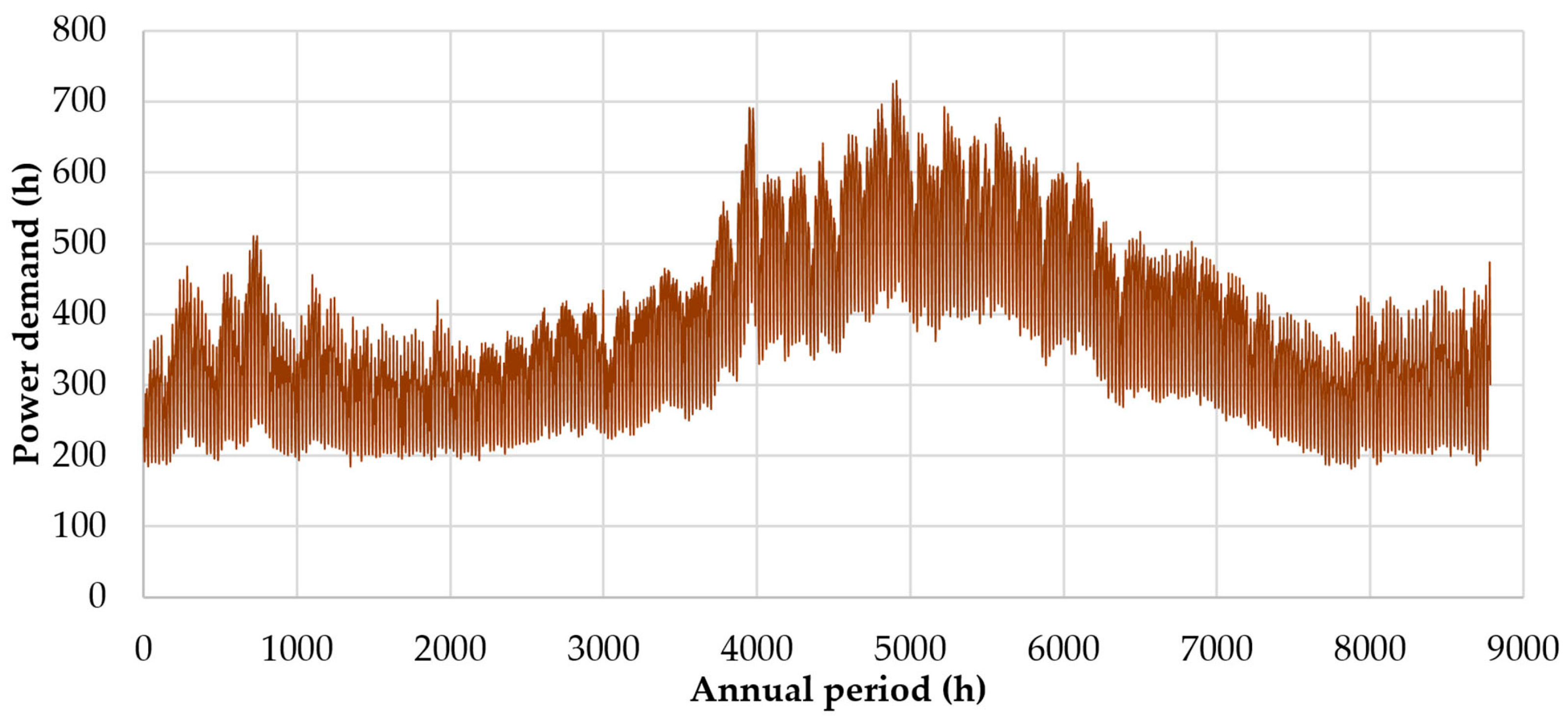
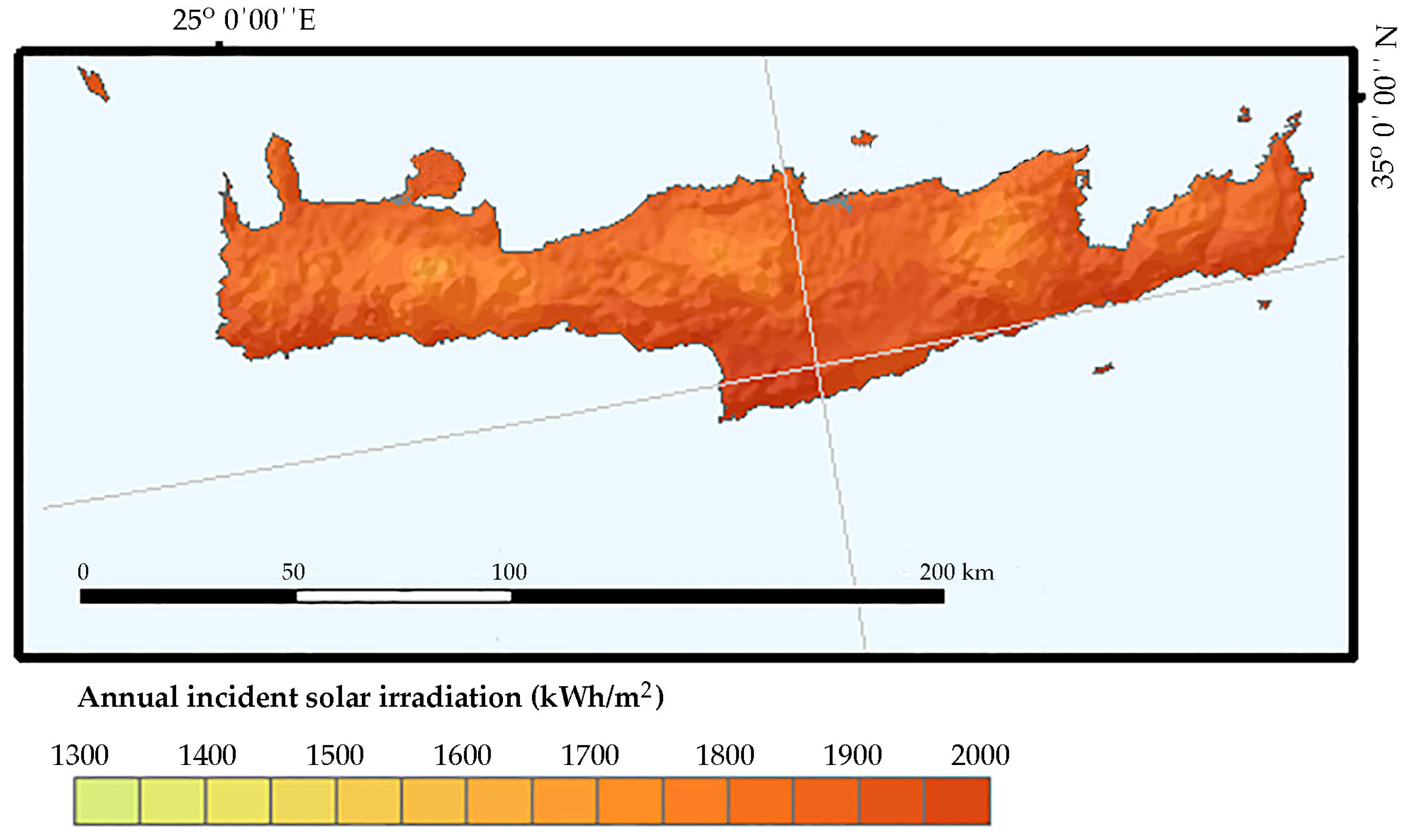
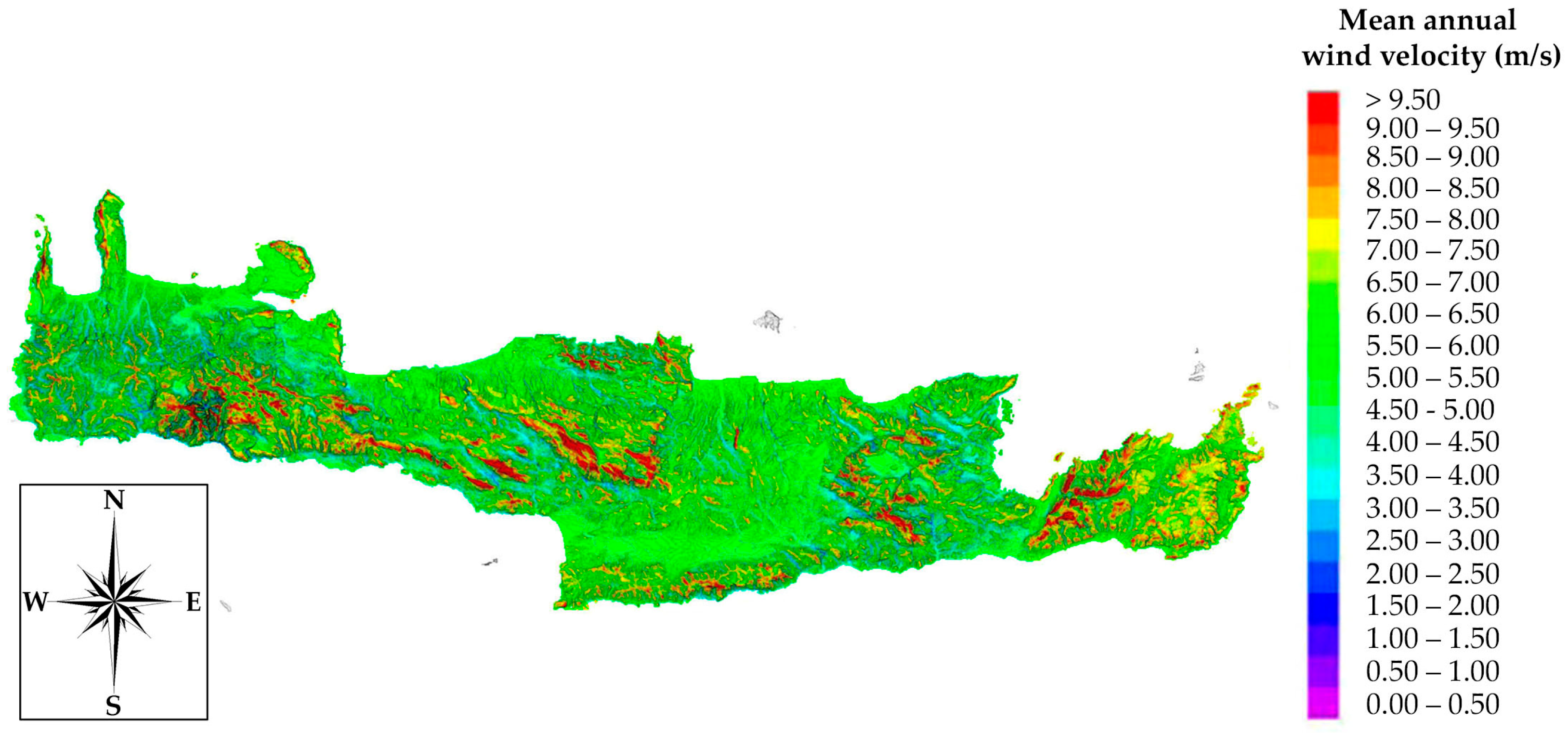
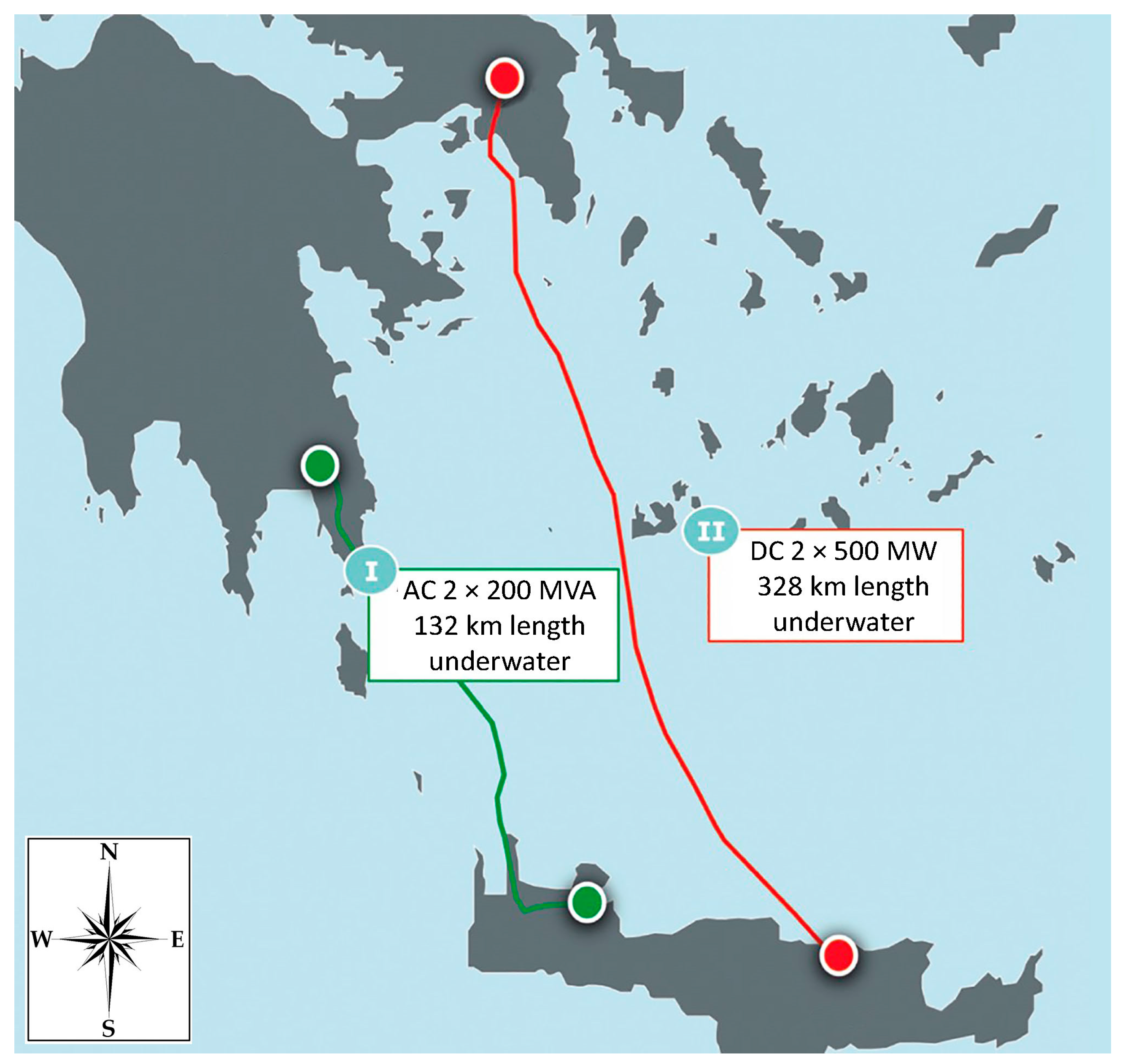
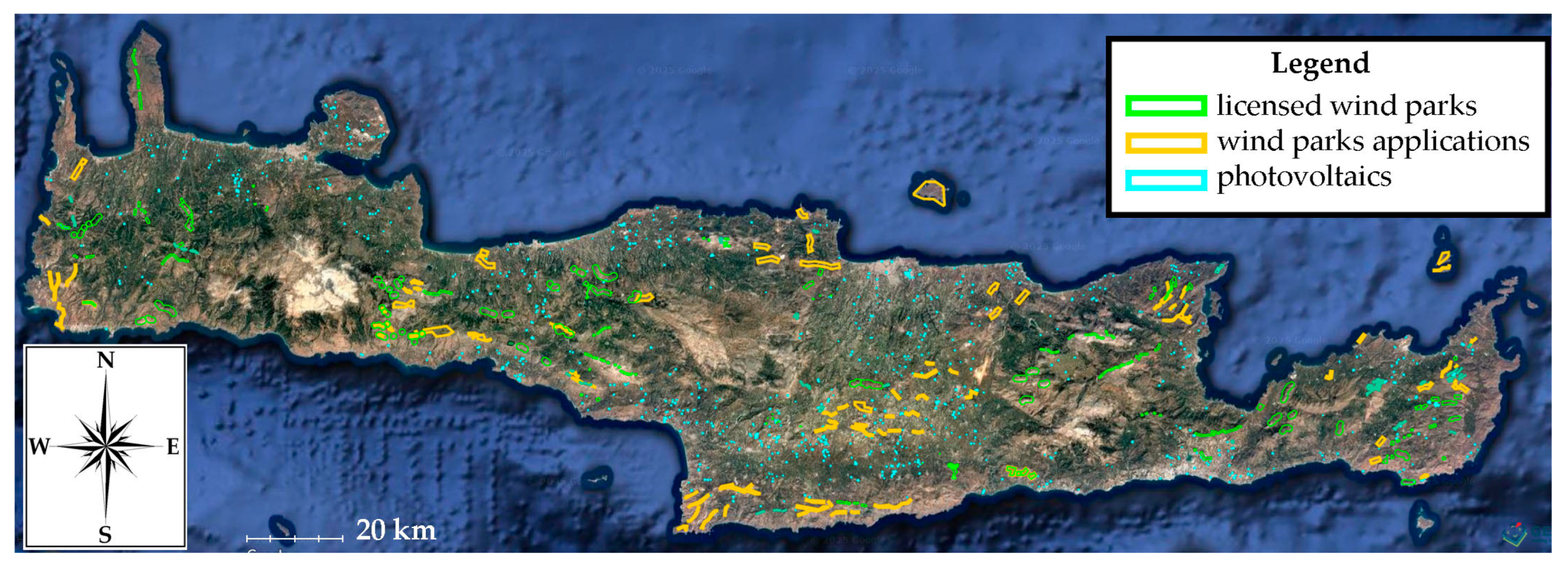
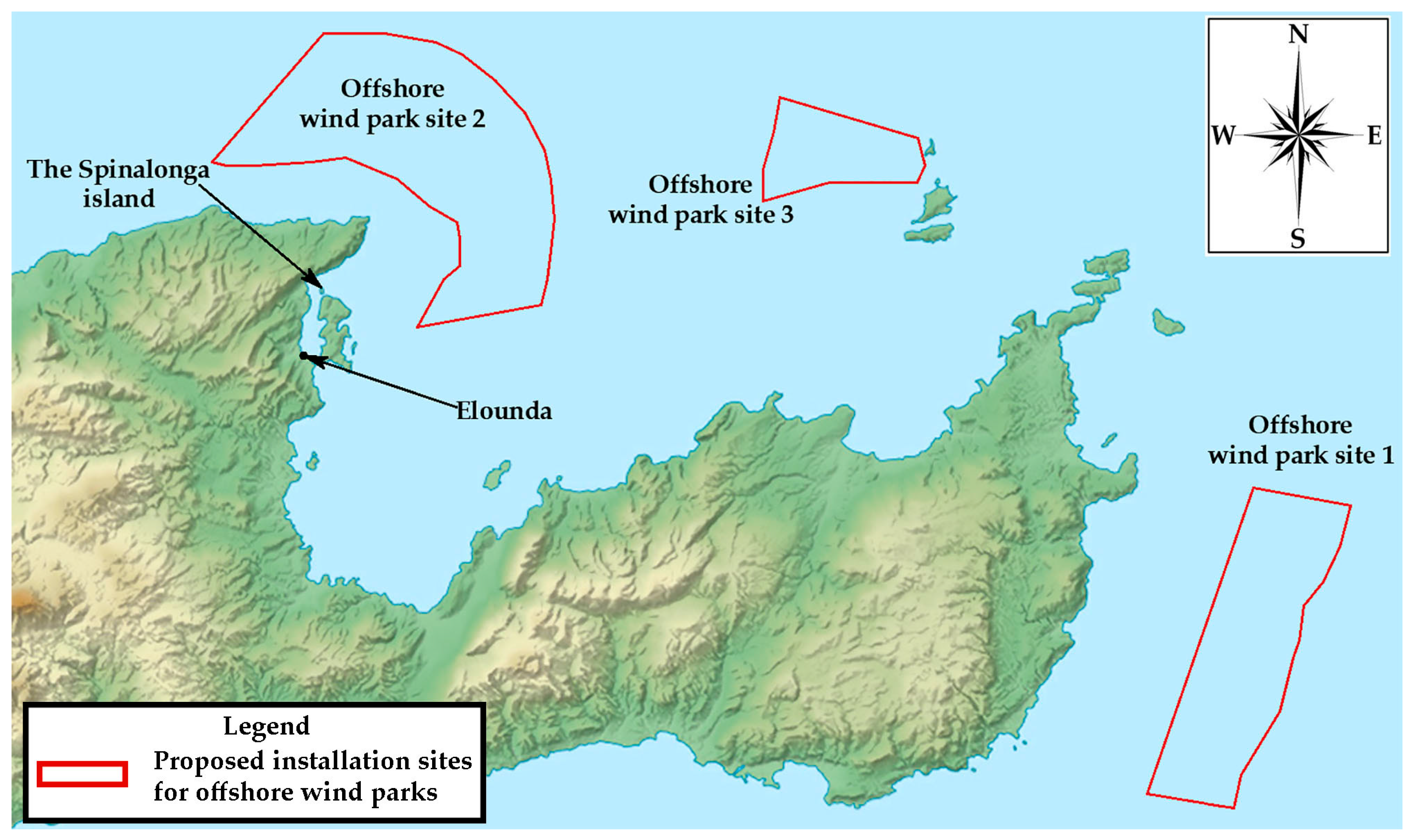
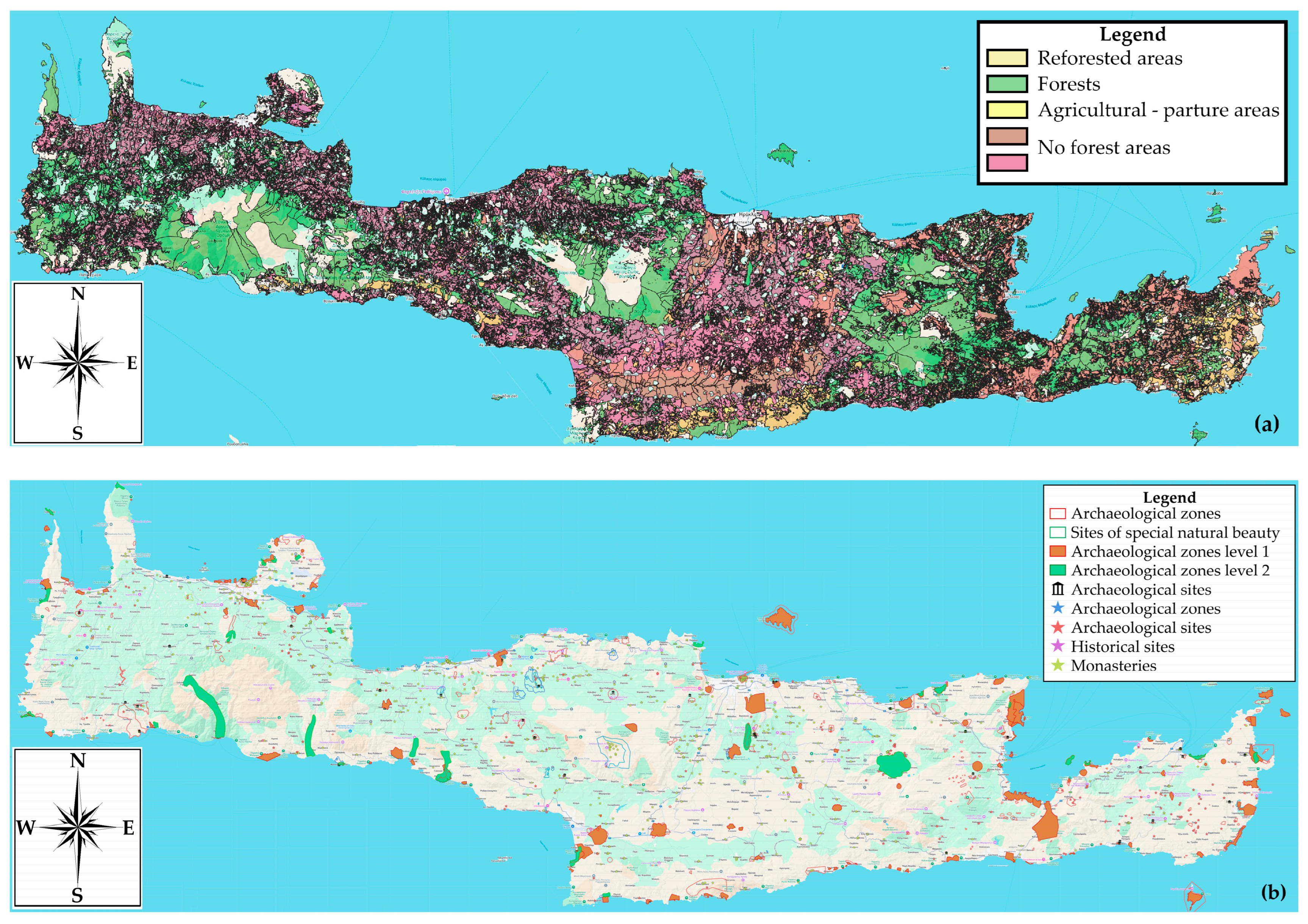
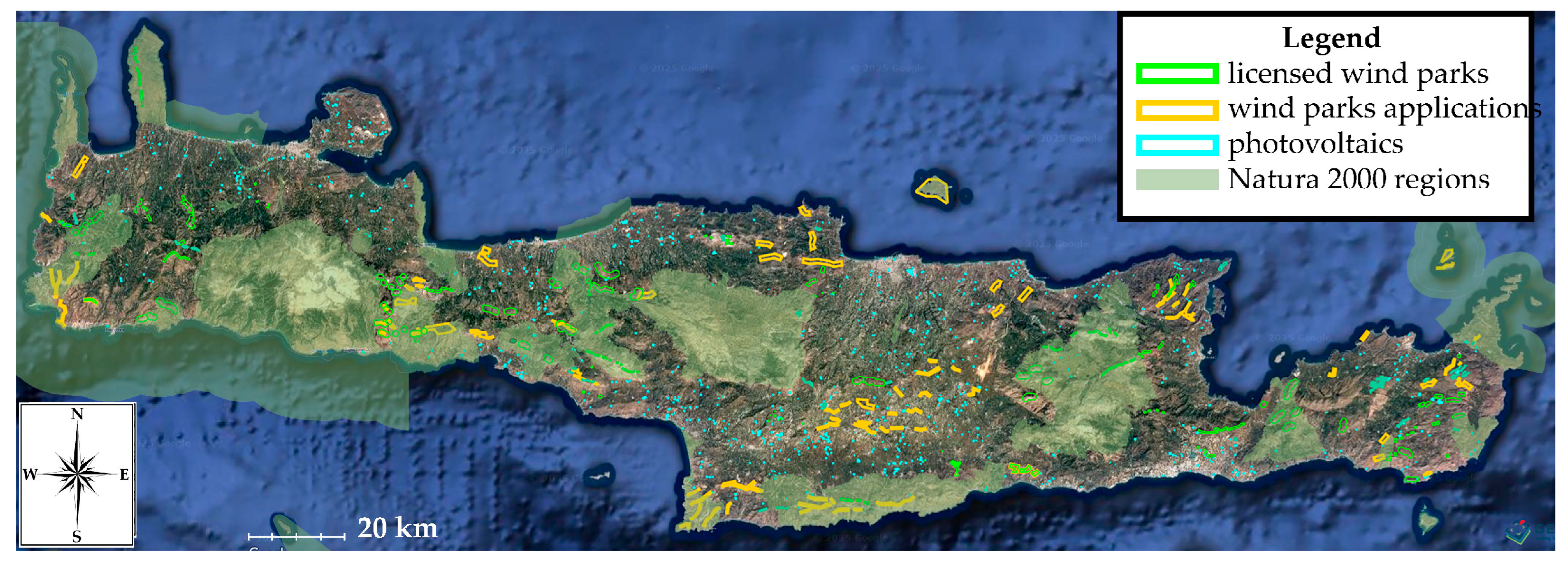
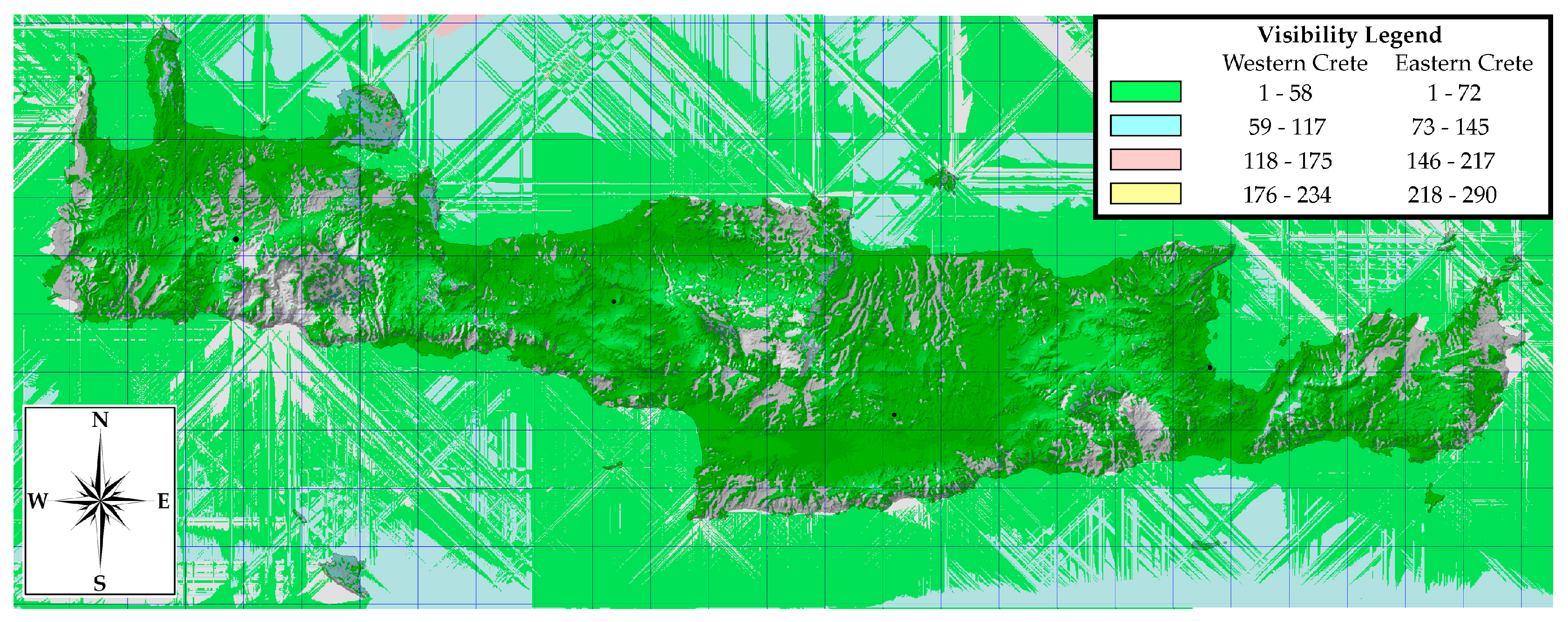
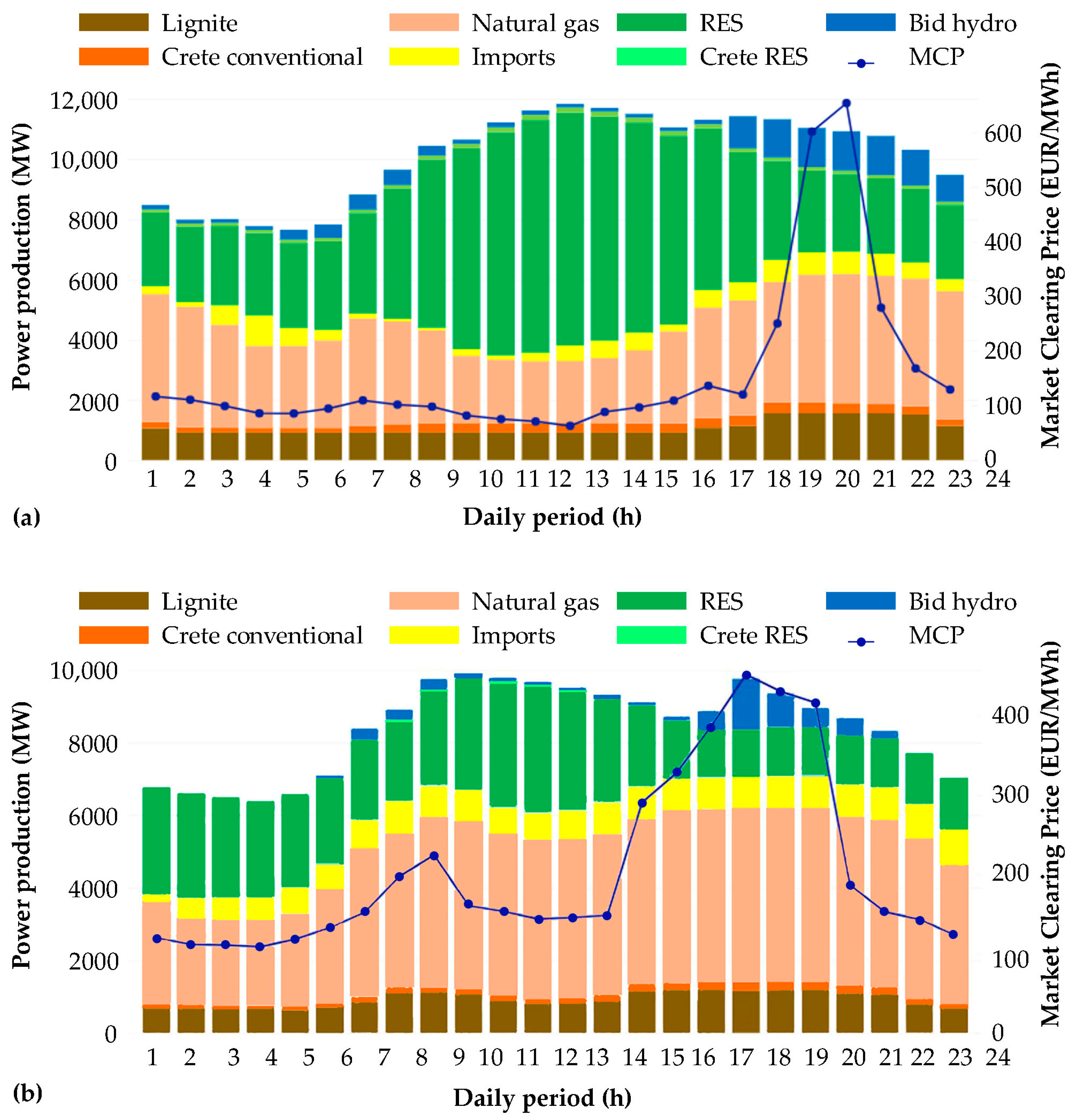
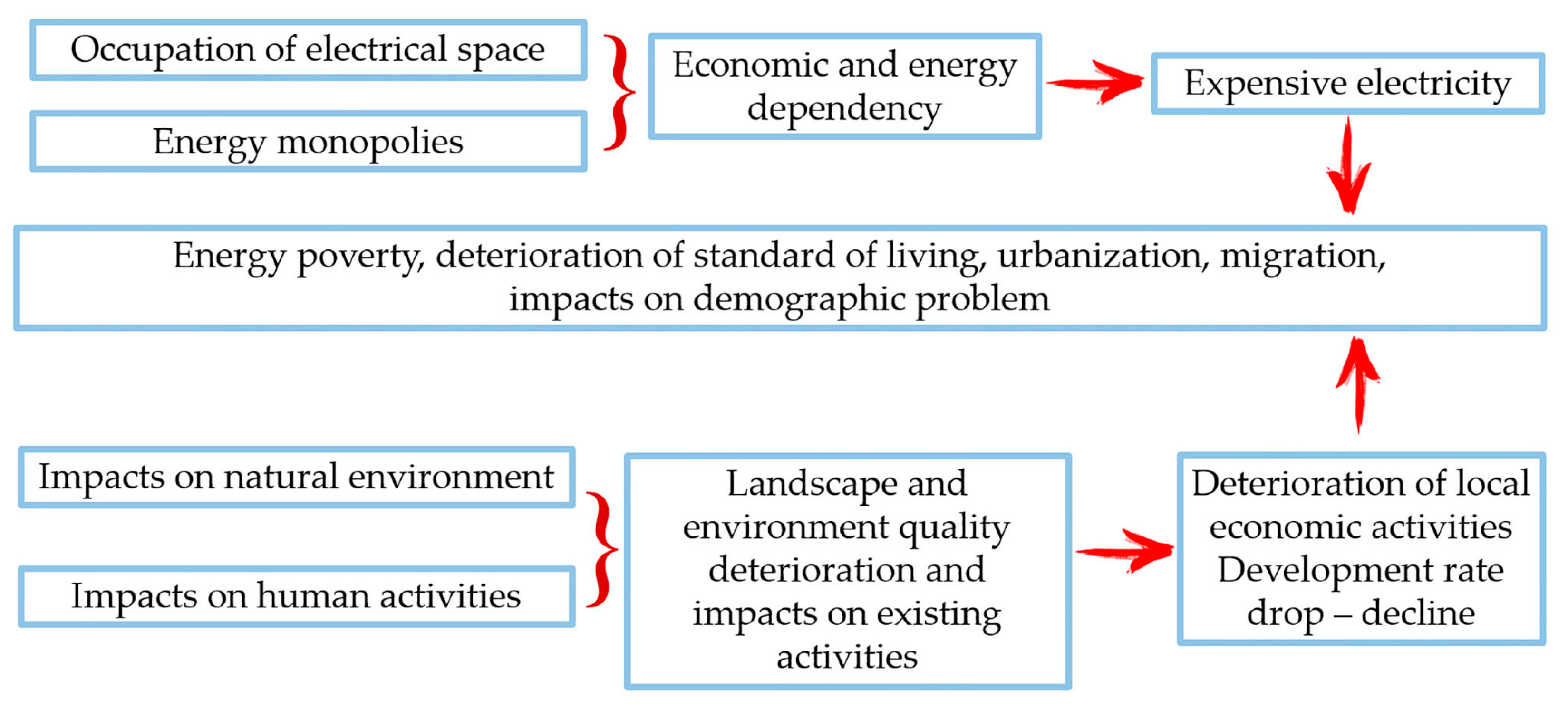
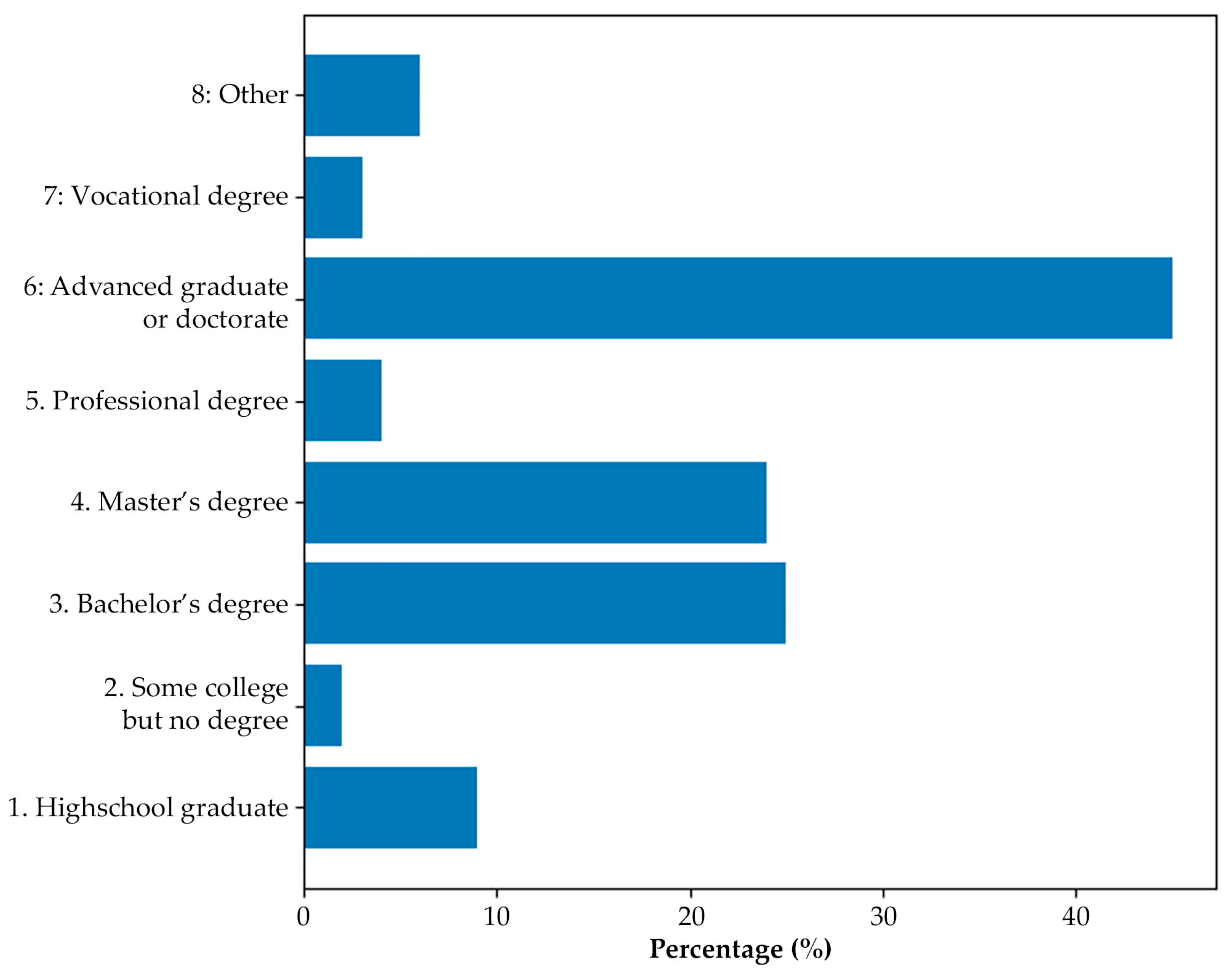

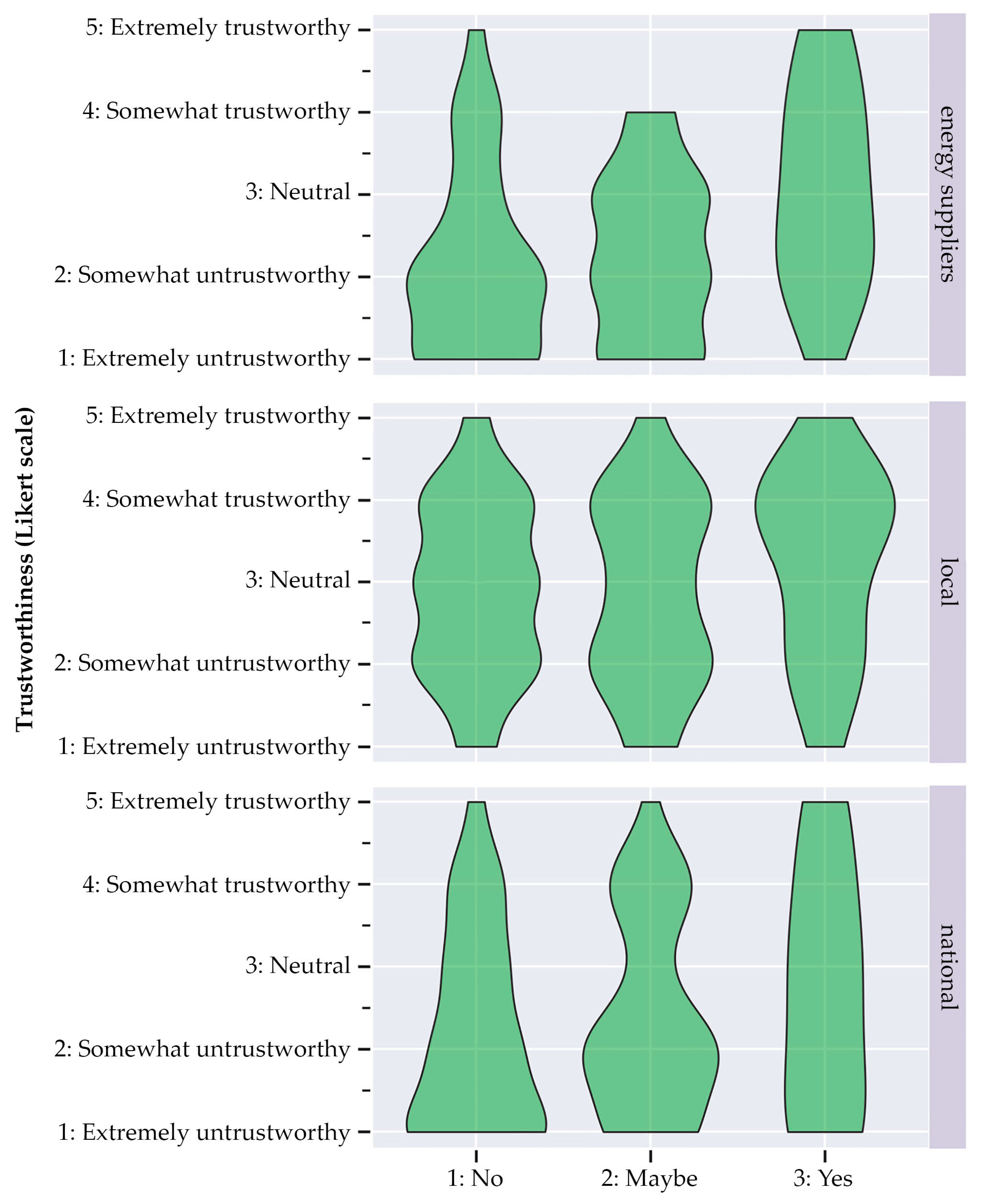
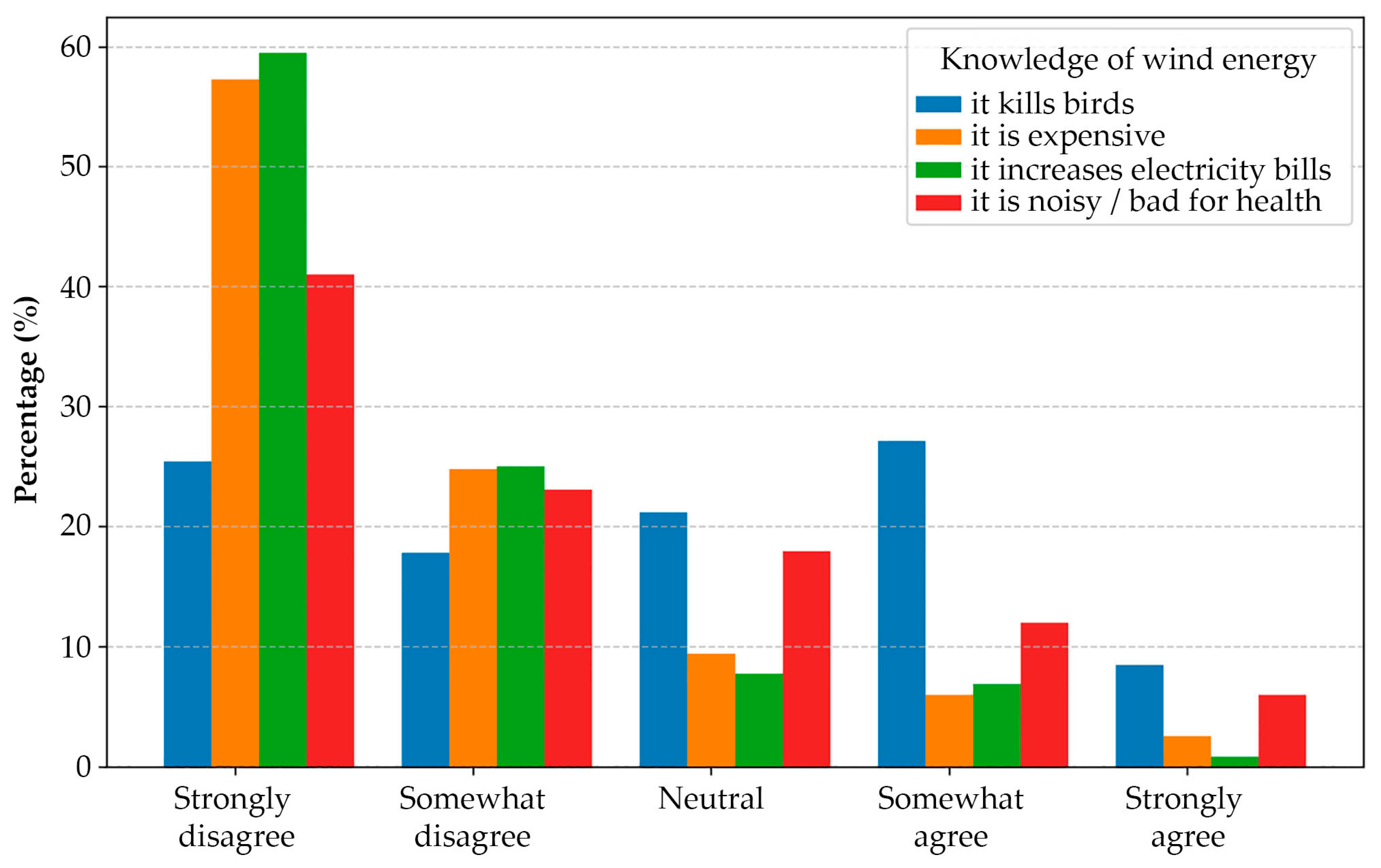
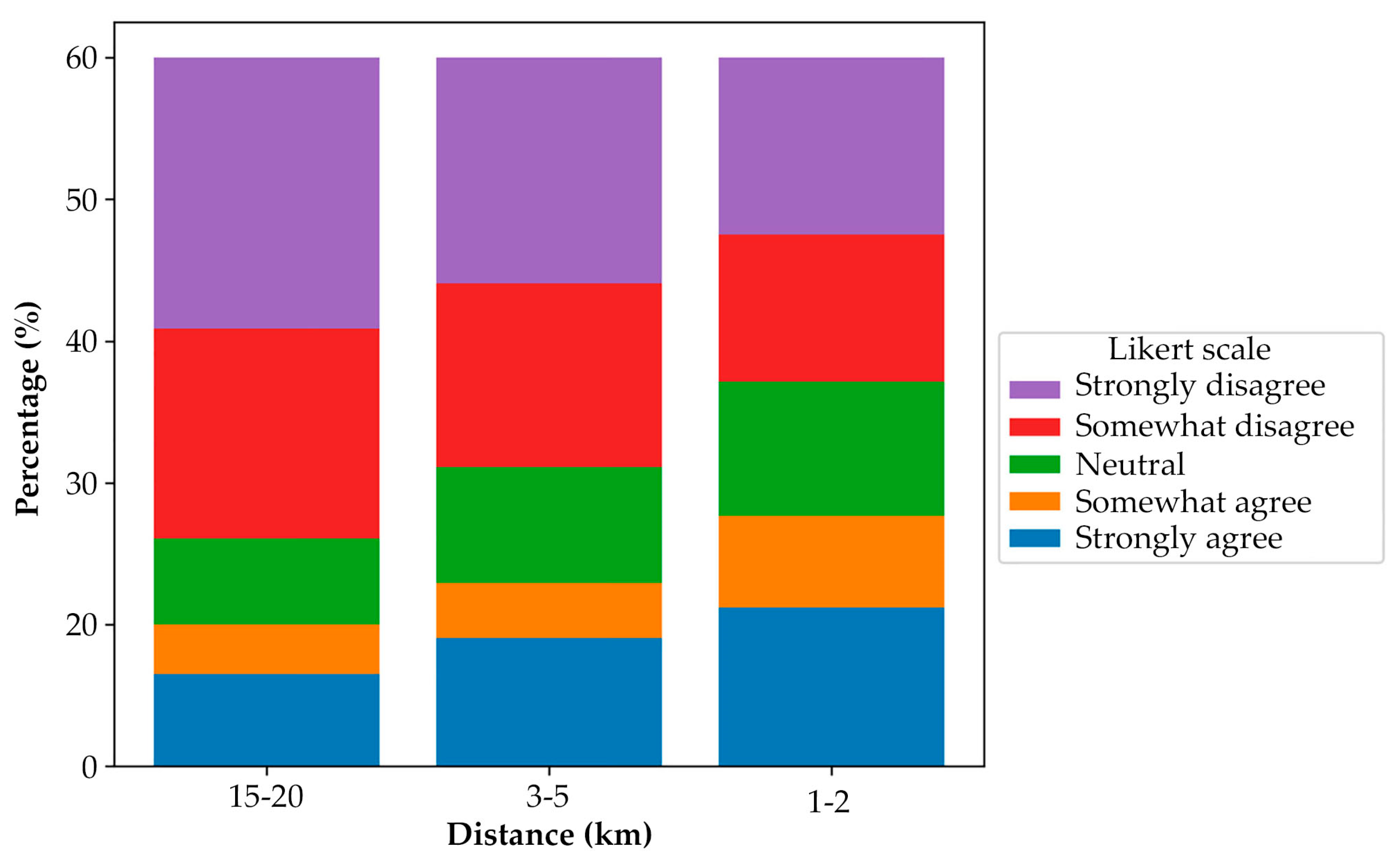
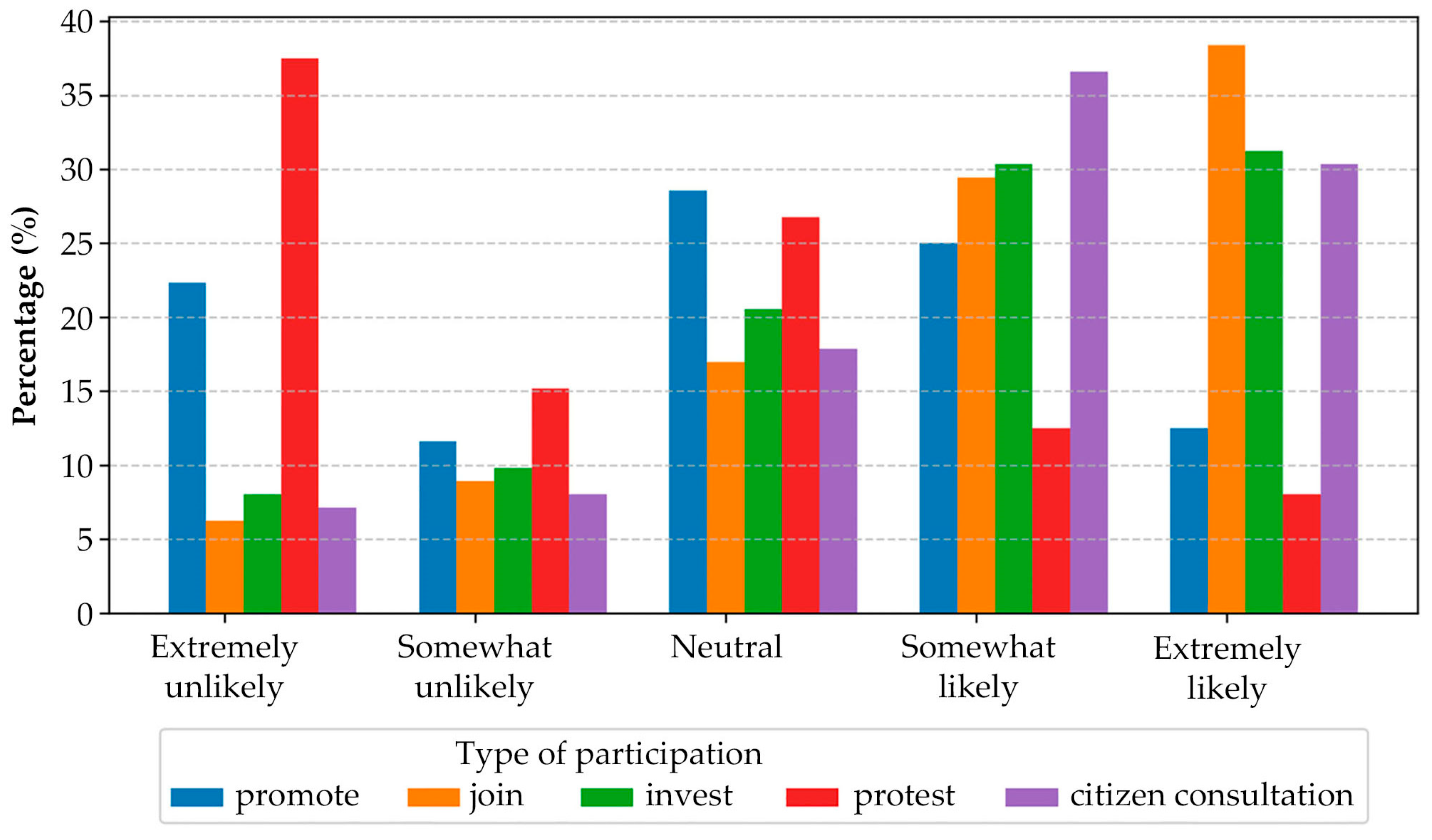
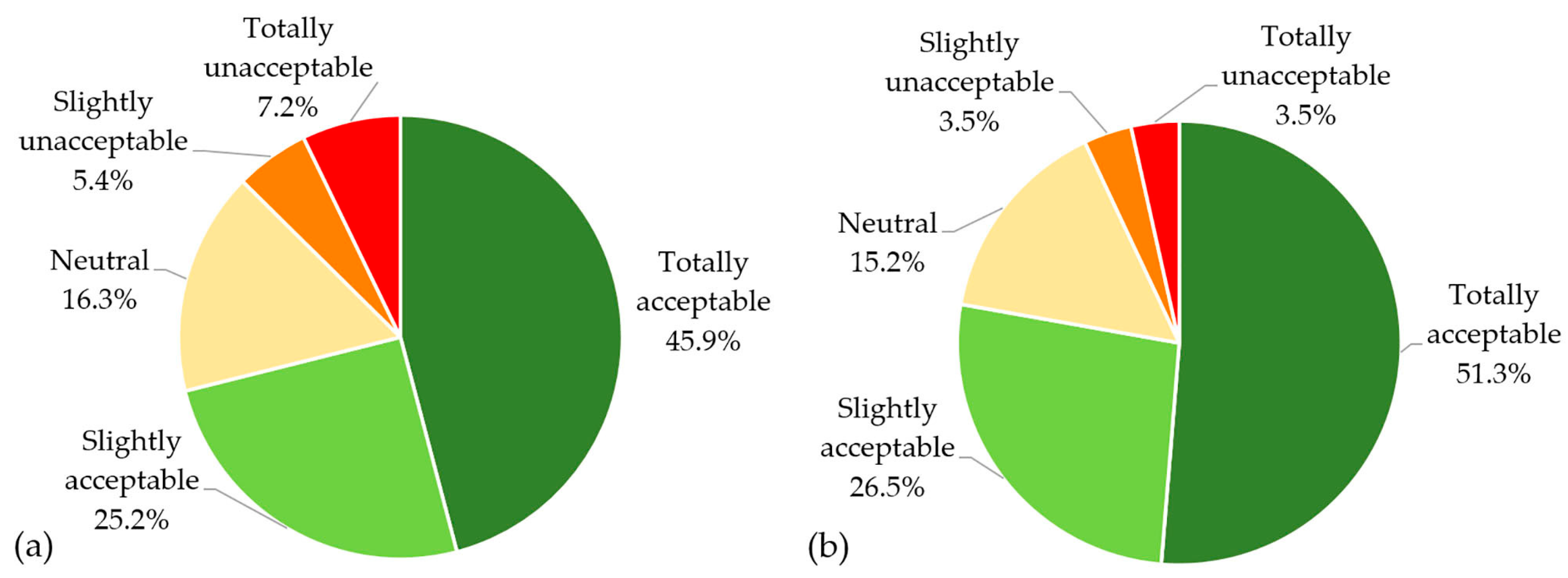
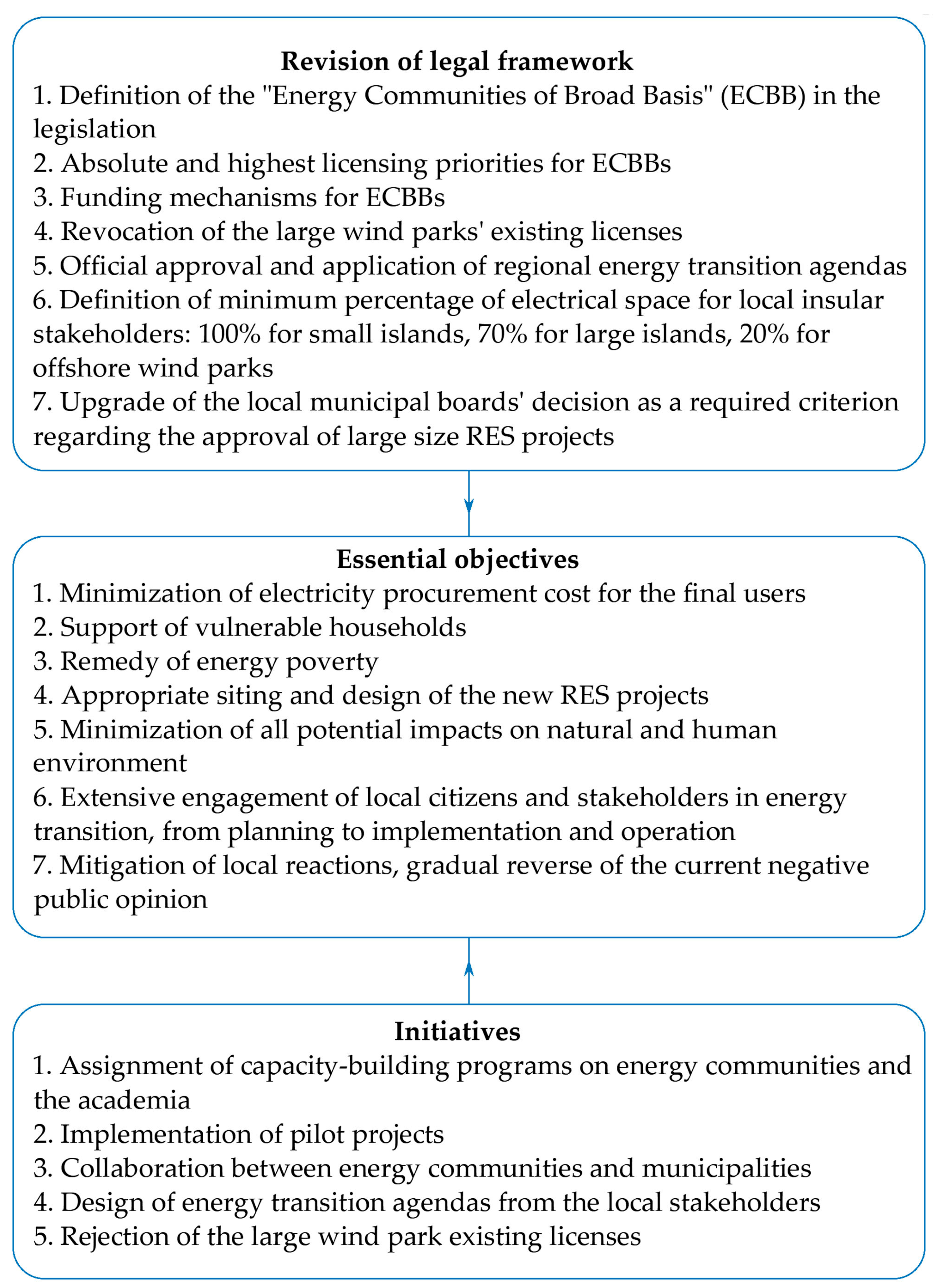
| Wind Turbine Model | Number Wind Turbines | Wind Turbine Model’s Nominal Power (MW) | Total Nominal Power (MW) | Rotor Diameter (m) | Hub Height (m) | Turbine’s Total Height (m) |
|---|---|---|---|---|---|---|
| Issued licenses | ||||||
| Siemens Gamesa SG 5.0-132 | 53 | 5 | 265 | 132 | 84 | 150 |
| Vestas V150/6 MW | 124 | 6 | 744 | 150 | 155 | 230 |
| Enercon E70/2.3 ΜW | 100 | 2.3 | 230 | 70 | 65 | 100 |
| Siemens Gamesa SG 6.6-155 | 87 | 6.6 | 574.2 | 155 | 102.5 | 180 |
| Vestas V162/6 MW | 37 | 6 | 222 | 162 | 149 | 230 |
| Vestas V90/3000 | 1 | 2 | 2 | 90 | 80 | 125 |
| Total: | 402 | 2037.2 | ||||
| Submitted applications under evaluation | ||||||
| Vestas V112/3000 | 295 | 3 | 885 | 112 | 84 | 140 |
| Enercon E70 E4 | 7 | 2.3 | 16.1 | 70 | 64 | 99 |
| Vestas V113/3000 | 25 | 3 | 75 | 113 | 84 | 140.5 |
| Enercon E70/2.3 ΜW | 9 | 2,3 | 20.7 | 70 | 65 | 100 |
| Enercon E82/3000 | 98 | 3 | 294 | 82 | 78 | 119 |
| Enercon E44/900 | 62 | 0,9 | 55.8 | 44 | 45 | 67 |
| Enercon E101/3000 | 76 | 3 | 228 | 101 | 99 | 149.5 |
| Vestas V90/3000 | 115 | 3 | 345 | 90 | 80 | 125 |
| Siemens Gamesa SG 6.6-155 | 9 | 6.6 | 59.4 | 155 | 102.5 | 180 |
| Sinovel SL-5000/128 | 31 | 5 | 155 | 128 | 100 | 164 |
| Total: | 727 | 2134.0 | ||||
| Id | Occupation | Frequency |
|---|---|---|
| 1 | Working full-time | 76 |
| 2 | Working part-time | 1 |
| 3 | Unemployed, looking for work | 1 |
| 4 | Retired, pensioner | 18 |
| 5 | Student | 7 |
| 6 | Homemaker, stay-at-home parent | |
| 7 | Other | 5 |
Disclaimer/Publisher’s Note: The statements, opinions and data contained in all publications are solely those of the individual author(s) and contributor(s) and not of MDPI and/or the editor(s). MDPI and/or the editor(s) disclaim responsibility for any injury to people or property resulting from any ideas, methods, instructions or products referred to in the content. |
© 2025 by the authors. Licensee MDPI, Basel, Switzerland. This article is an open access article distributed under the terms and conditions of the Creative Commons Attribution (CC BY) license (https://creativecommons.org/licenses/by/4.0/).
Share and Cite
Katsaprakakis, D.; Papadakis, N.C.; Savvakis, N.; Vavvos, A.; Dakanali, E.; Yfanti, S.; Condaxakis, C. The Wind Parks Distorted Development in Greek Islands—Lessons Learned and Proposals Toward Rational Planning. Energies 2025, 18, 3311. https://doi.org/10.3390/en18133311
Katsaprakakis D, Papadakis NC, Savvakis N, Vavvos A, Dakanali E, Yfanti S, Condaxakis C. The Wind Parks Distorted Development in Greek Islands—Lessons Learned and Proposals Toward Rational Planning. Energies. 2025; 18(13):3311. https://doi.org/10.3390/en18133311
Chicago/Turabian StyleKatsaprakakis, Dimitris, Nikolaos Ch. Papadakis, Nikos Savvakis, Andreas Vavvos, Eirini Dakanali, Sofia Yfanti, and Constantinos Condaxakis. 2025. "The Wind Parks Distorted Development in Greek Islands—Lessons Learned and Proposals Toward Rational Planning" Energies 18, no. 13: 3311. https://doi.org/10.3390/en18133311
APA StyleKatsaprakakis, D., Papadakis, N. C., Savvakis, N., Vavvos, A., Dakanali, E., Yfanti, S., & Condaxakis, C. (2025). The Wind Parks Distorted Development in Greek Islands—Lessons Learned and Proposals Toward Rational Planning. Energies, 18(13), 3311. https://doi.org/10.3390/en18133311






